In spite of the fact that everything comes from the Supreme Being, He is still aloof from it all. He does not disengage Himself from His eternal pleasure pastimes with His devotees in the spiritual realm. So, in the process of creating the material worlds, the Supreme expands Himself into various forms, which are His plenary parts. Krishna is the primeval Lord, the original Personality of Godhead, so He can expand Himself into unlimited forms with all potencies. They are no different from Him, but may exhibit differences in form.
He first expands Himself into Baladeva, or Balarama, who is considered Krishna’s second body and brother. Balarama assists in Lord Krishna’s innumerable spiritual pastimes in both the spiritual and material realms.
Lord Balarama is also Lord Sankarshana, the predominator of the creative energy. He creates and is the shelter of the material and spiritual worlds. By the will of Krishna and the power of the spiritual energy, Lord Balarama creates the spiritual world, which consists of the planet Goloka Vrindavana and the Vaikuntha planets. 1
Lord Balarama especially assists Lord Krishna in the creation of the material worlds. After Balarama has expanded Himself into Lord Maha-Sankarshana, He expands Himself into four different forms, including: 1) Karanadakashayi Vishnu [Maha-Vishnu], 2) Garbhodakashayi Vishnu [the expansion in each universe], 3) Ksirodakashayi Vishnu [the Supersoul in each individual], and 4) Sesha, also called Seshanaga. These first four plenary portions assist in the material cosmic manifestation. Sesha is Balarama’s form who assists in the Lord’s personal service. He is also called Ananta, meaning unlimited, because He assists the Lord in His unlimited variety of pastimes. 2
* * *
To explain more clearly, all expansions of the Lord begin with Sri Krishna. For His pastimes in one of the highest levels of the spiritual realm, called Dvaraka, Sri Krishna expands Himself into Balarama, who then expands Himself into Pradyumna and Aniruddha. These four expand into a second quadruple which is present in the unlimited Vaikuntha planets of the spiritual sky. The second quadruple is known as Vasudeva, Sankarshana, Pradyumna and Aniruddha. They are changeless, transcendental expansions of the Supreme Lord, Krishna. In this second quadruple, Vasudeva is an expansion of Krishna, and Sankarshana is a representation of Balarama.
In the Vaikuntha sky there is the pure, spiritual creative energy called Shuddha-sattva that sustains all of the spiritual planets with the full opulences of knowledge, wealth, power, beauty, etc., all of which pervade the entire spiritual kingdom and are fully enjoyed by the residents there. This energy is but a display of the creative potencies of Balarama, Maha-Sankarshana. It is also this Sankarshana who is the original cause of the Causal Ocean where Karanodakashayi Vishnu (Maha-Vishnu) sleeps, while breathing out the seeds of innumerable universes. When the cosmic creation is annihilated, all of the materially conditioned, although indestructible, living entities merge back into the body of Maha-Vishnu where they rest until the time of the next creation. So, Balarama as Sankarshana is the origin of Maha-Vishnu, from whom originates all of the potencies of the material manifestation. 3
So, to summarize, for His spiritual pastimes in the Vaikuntha realm, Lord Krishna has four original expansions, namely Vasudeva, Sankarshana, Pradyumna and Aniruddha. Maha-Vishnu is an expansion of Sankarshana; Garbhodakashayi Vishnu is an expansion of Pradyumna; and Ksirodakashayi Vishnu is an expansion of Aniruddha. 4
* * *
To begin explaining the purpose and function of these expansions, the Srimad-Bhagavatam (2.6.42) describes that, “Maha-Vishnu (Karanadakashayi Vishnu) is the first incarnation of the Supreme Lord in the process of creating the material worlds. He is the master of eternal time, space, cause and effects, mind, elements, material ego, the modes of nature, senses, the universal form of the Lord (Garbhodakashayi Vishnu) and the sum total of all living beings, both moving and nonmoving.”
Then Maha-Vishnu lies down in the Viraja River, which is the border between the spiritual and material worlds. 5
Lord Maha-Vishnu is the source of thousands of avataras in His thousands and thousands of subjective portions. He is the creator of countless individual souls. He is also known by the name of Narayana, meaning the shelter of all the individual jiva souls. From Him springs forth the vast expanse of water known as the spiritual Causal Ocean. Maha-Vishnu then reclines in the waters of the Causal Ocean in a state of divine sleep, called yoga-nidra. Thus, it is said that the universal creation is but the dream of Maha-Vishnu. 6
Since the waters of the Causal Ocean, known as the Karana Ocean, come from the body of Maha-Vishnu, it is completely spiritual. The sacred Ganges is but a drop from that ocean, which can purify the fallen souls. 7
Lord Balarama also expands into the great serpent known as Ananta, or Seshanaga. He reposes on the Causal Ocean and serves as the couch upon whom Lord Maha-Vishnu reclines. 8
That Ananta-Sesha is the devotee incarnation of God who knows nothing but service to Lord Krishna. With His thousands of mouths He always sings the endless glories of Lord Krishna. He also expands Himself to serve as Lord Krishna’s paraphernalia, including such items as the umbrella, slippers, bedding, pillow, garments, resting chair, residence, sacred gayatri thread, and throne in the pastimes of Lord Krishna. Thus, He has attained and exhibits the ultimate end of servitude to Lord Krishna. 9
At the time of creation, after the Supreme has been sleeping for some time, the first emanation from the breathing of Lord Maha-Vishnu are the personified Vedas who serve Him by waking Him from His mystic sleep. They begin to enthusiastically sing His glories, pastimes, and praises, just as a King is awaken in the morning by poets who recite his heroic deeds. 10 This shows the eternal nature of the Vedic literature. They are not merely the writings of men, but they are spiritual vibrations that exist before and after the material creation, and which emanate from the Supreme Lord.
Once the Lord is awoken, He casts His glance upon the material energy of maya. Then she becomes agitated. At that time the Lord injects the original seeds of all living entities. This glance is how the Supreme impregnates material nature with all the living entities. Thus, the Lord does not personally touch the material energy, but by His functional expansion He places the living entities into the material nature by His glance. 11 This functional expansion of the Lord takes the form as Shiva, which will be explained later.
After agitating material nature into three qualities, which are the modes of nature in the form of passion, goodness, and ignorance, they become active and material nature begins to give birth to the total material energy known as the hiranya-mahat-tattva. This is the sum total of cosmic intelligence. Thus, material nature becomes agitated by the destinations of the conditioned souls as determined by the influence of the modes of nature. 12
Simply by the glance of Maha-Vishnu consciousness is created, which is known as the mahat-tattva. The predominating Deity of the mahat-tattva is Lord Vasudeva, another expansion of Lord Krishna. This explains how the material energy is like the mother of the living beings while the Lord is the Supreme Father of everyone. Just as a woman cannot give birth without the contact of a man, or at least his seed, so material nature cannot create without the contact of the Supreme Being.
So, first the total material energy is manifest, and from this arise the three types of egotism, which are the original sources of all the demigods [the minor controlling deities], the senses, and material elements. By combining the different elements, the Supreme Lord creates all of the unlimited universes. Once the material elements have been manifested, and the full potential for creating the universes has been established, the innumerable universes begin to emanate from the pores of the body of Maha-Vishnu, and from His exhalations. They appear just like atomic particles that float in sunshine and pass through a screen. When Maha-Vishnu inhales at the time of the universal annihilation, they return to His body. In this way, Maha-Vishnu is the Supersoul of all the universes. 13
Brahma, the demigods, and each universe remain alive for the duration of one of His exhalations. 14 However, there is no limit to the exhalations of Maha-Vishnu. 15
Once all of the universes are created, which are unlimited, Maha-Vishnu expands Himself into unlimited forms and enters each universe as Garbhodakashayi Vishnu. Once He is in each universe, He sees that there is no place to reside. Then, after some consideration, He fills half of the universe with water from His own perspiration. He then lays down on the water, again supported by the bed of Seshanaga. 16
Garbhodakashayi Vishnu, who is known within the universe as Hiranyagarbha and Antaryami, the Supersoul, is glorified in the Vedic hymns. He is the master of each and every universe and shelter of the external or material energy. However, being transcendental, He is completely beyond the touch of the external energy.
Next is the third expansion of Vishnu, called Ksirodakashayi Vishnu, who is the incarnation of the quality of goodness. He is the universal form of the Lord and expands Himself as the Supersol within every living entity. He is known as Ksirodakashayi Vishnu because He lies on the ocean of milk on the island of Svetadvipa. These are the three expansions of Lord Vishnu who oversee and make the creation of the material world possible. 17
In this way, we can see how all of the expansions of the Lord, and also all of His energies that are manifested to bring forth the cosmic creation, all originate from Lord Krishna. Therefore, the reason why Lord Krishna is considered the ninth incarnation is only because this is the order in which He displays His avatars before He displays His own pastimes. Basically, if we can further understand this description, everything is but a pastime of the Lord.
A few additional verses that clarify this topic include the 3rd chapter of the 1st Canto of Srimad-Bhagavatam which describes the principle incarnations of the Supreme Lord. Having done that, verse 28 says:
ete camsha-kalah pumsah
krsnas tu bhagavan svayam
indrari-vyakulam lokam
mridayanti yuge yuge
“All of the above-mentioned incarnations are either plenary portions or portions of the plenary portions of the Lord, but Lord Sri Krishna is the original Personality of Godhead. All of them appear on planets whenever there is a disturbance created by the atheists. The Lord incarnates to protect the theists.”
Also in Brahma Samhita (5.1) Lord Brahma says:
isvarah paramah krishnah sac-cid-ananda-vigrahah
anadir adir govindah sarva-karana-karanam
“Krishna who is known as Govinda is the Supreme Godhead. He has an eternal blissful spiritual body. He is the origin of all. He has no other origin and He is the prime cause of all causes.”
In this way, the Vedic literature agrees that Krishna is the source of Brahma, Shiva and all other demigods. In the Atharva Veda (Gopala-tapani Upanishad 1.24) it is said, yo brahmanam vidadhati purvam yo vai vedamsh cha gapayati sma krishnah: “It was Krishna who in the beginning instructed Brahma in Vedic knowledge and who disseminated Vedic knowledge in the past.”
Then the Narayana Upanishad (1) says, atha purusho ha vai narayano kamayata prajah srijeyeti: “Then the Supreme Personality Narayana desired to create living entities.” The Upanishad continues, narayanad brahma jayate, narayanad prajapatih prajayate, narayanad indro jayate, narayanad ashtau vasavo jayante, narayanad ekadasha rudra jayante, narayanad dvadashadityah: “From Narayana, Brahma is born, and from Narayana the patriarchs are also born. From Narayana, Indra is born, from Narayana the eight Vasus are born, from Narayana the eleven Rudras are born, from Narayana the twelve Adityas are born.”
This Narayana is an expansion of Krishna as previously explained.
It is further said in the Narayana Upanishad 4, brahmanyo devaki-putrah: “The son of Devaki, Krishna, is the Supreme Personality.”
In the Moksha-dharma Sri Krishna Himself says,
prajapatim cha rudram chapy aham eva srijami vai
tau hi mam na vijanito mama maya-vimohitau
“The patriarchs, Shiva and others are created by Me, though they do not know that they are created by Me because they are deluded by My illusory energy.”
Lord Brahma continues to pray and explains in his Brahma Samhita (5.46) how the potency in Krishna’s expansions spreads from one form to another:
diparchir eva hi dashantaram abhyupetya
dipayate vivrita-hetu-samana-dharma
yas tadrig eva hi cha vishnutaya vibhati
govindam adi-purusham tam aham bhajami
“The light of one candle being communicated to other candles, although it burns separately in them, is the same in its quality. I adore the primeval Lord Govinda who exhibits Himself equally in the same mobile manner in His various manifestations.”
Thus, the Vedic knowledge clearly accepts Sri Krishna (Govinda) as the original independent causeless fountainhead of all of His various personality manifestations known as the various Vishnu avataras (forms/personalities).
CHAPTER NOTES
1. Chaitanya-caritamrita, Madhya-lila, 20.255-6
2. Ibid., Adi-lila, 5.4-6, 8-11
3. Ibid., Adi-lila, 5.41 & purport
4. Ibid., Adi-lila, 2.56, purport
5. Ibid., Madhya-lila, 20.268-271
6. Brahma-samhita, 5.11-12
7. Chaitanya-caritamrita, Adi-lila, 5.54
8. Brahma-samhita, 5.47
9. Chaitanya-caritamrita, Madhya-lila, 5.120-124
10. Srimad-Bhagavatam, 10.87.12-13
11. Chaitanya-caritamrita, Madhya-lila, 20.272
12. Srimad-Bhagavatam, 3.26.19
13. Chaitanya-caritamrita, Madhya-lila, 20.275-282
14. Brahma-samhita, 5.48
15. Chaitanya-caritamrita, Madhya-lila, 20.324
16. Ibid., Madhya-lila, 20.284-6
17. Ibid., Madhya-lila, 20.292, 294-5
[More information found at: http://www.stephen-knapp.com]
 By Mina Sharma
By Mina Sharma  By Krishna Bhagavan dasa
By Krishna Bhagavan dasa By Bhakti-latā Dasi
By Bhakti-latā Dasi






 Please find the Kids Bhagvatam summary video for Canto1, Chapter 2 - "Divinity and Divine Service". We pray this inspires some of you to try this teaching methodology with your kids at home/Sunday school etc. Please write to me personally if you would like to use any of the resources. We seek your blessings to continue this journey of learning Srimad Bhagavatam.
Please find the Kids Bhagvatam summary video for Canto1, Chapter 2 - "Divinity and Divine Service". We pray this inspires some of you to try this teaching methodology with your kids at home/Sunday school etc. Please write to me personally if you would like to use any of the resources. We seek your blessings to continue this journey of learning Srimad Bhagavatam. So we are worshiping Krishna. His simple business is, as we have described, RadhaMadhava, He is lover of SrimatiRadharani. Krishna means lover. This very word Krishna means "all-attractive”. You can attract by your love, not by anything else
So we are worshiping Krishna. His simple business is, as we have described, RadhaMadhava, He is lover of SrimatiRadharani. Krishna means lover. This very word Krishna means "all-attractive”. You can attract by your love, not by anything else
 The BBT is releasing a trove of more than a dozen letters exchanged between Hayagriva Dasa and Jayadvaita Dasa about Bhagavad-gita As It Is while the book was in production.
The BBT is releasing a trove of more than a dozen letters exchanged between Hayagriva Dasa and Jayadvaita Dasa about Bhagavad-gita As It Is while the book was in production. By Yamuna Devi Dasi
By Yamuna Devi Dasi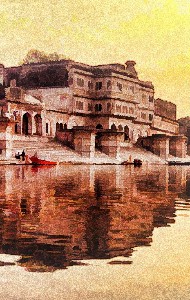 By Brahmananda Dasa
By Brahmananda Dasa  By Bhakti Caru Swami
By Bhakti Caru Swami

 Adult Education At The Temple
Adult Education At The Temple

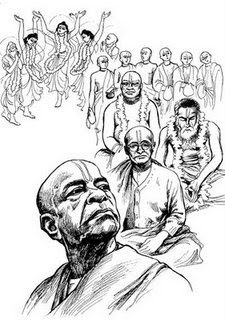





 Praghosa dasa: The Manor are now accepting applications for grants from their total annual fund of £10,000. Individual grants of between £500 to £4000 are generally successful as the fund is usually split up between a few causes.
Praghosa dasa: The Manor are now accepting applications for grants from their total annual fund of £10,000. Individual grants of between £500 to £4000 are generally successful as the fund is usually split up between a few causes. Today morning we met and wished Smt. Sheila Dixit President Delhi Pradesh Indian National Congress and Formar Chief Minister Delhi @ her residence
Today morning we met and wished Smt. Sheila Dixit President Delhi Pradesh Indian National Congress and Formar Chief Minister Delhi @ her residence By Satyaraja Dasa
By Satyaraja Dasa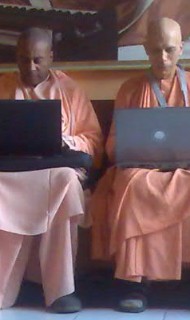 By Chaitanya Charana Dasa
By Chaitanya Charana Dasa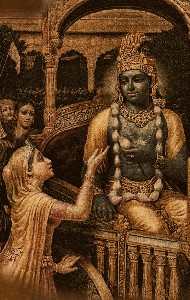 By His Divine Grace A.C. Bhaktivedanta Swami Prabhupada
By His Divine Grace A.C. Bhaktivedanta Swami Prabhupada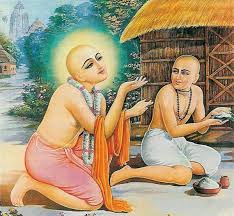



 World Biggest Shrimad Bhagavad Gita as it is, Arrived at ISKCON Delhi
World Biggest Shrimad Bhagavad Gita as it is, Arrived at ISKCON Delhi It is with mixed feelings that I enter the crematorium, after all, it is a place of death. Although I have come here many times, I still become very thoughtful each time I revisit this place. Maybe it is because I am reminded of my own mortality.
It is with mixed feelings that I enter the crematorium, after all, it is a place of death. Although I have come here many times, I still become very thoughtful each time I revisit this place. Maybe it is because I am reminded of my own mortality. By Vishakha Devi Dasi
By Vishakha Devi Dasi By Srutakirti dasa
By Srutakirti dasa By Archana Siddhi Devi Dasi
By Archana Siddhi Devi Dasi